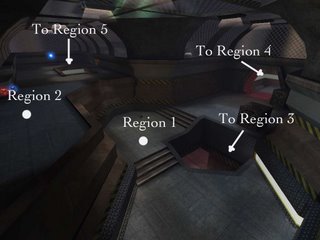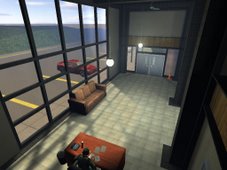INTRODUCTION
LESSON 1
Where to begin, right? Every wild brained designer wants to just jump in and start constructing maps that end up looking like modern art and winds up never getting finished. I know, I've been there. But nothing is worse than jumping into a map without a plan. It doesn't work for the military, and it doesn't work here either. Before you roll your eyes and let out a huge sigh, let me reassure you that this isn't as painful as it sounds. In fact, there's even room for a little improvisational work as you go, so don't sweat it.

SUIT YOURSELF
Probably the first thing you need to figure out is what genre of map you are going to create. There are numerous genres of maps you can make and some of them are, but not limited to: modern, gothic, ancient, futuristic, tech, alien, organic, and any hybrid of one or more of these styles. A lot of what you are going to build relies on the texture sets that you have access to. If you have never made a map in your entire life, it would probably be the best to start with a map with a modern setting. I say this simply because there are so many references and styles in our modern culture that it's hard to not come up with good ideas. Just look around you! Maps that are pure fiction or fantasy require a lot of research on what the expectations are regarding that genre, and generally speaking, it's tougher geometry to construct. The next thing to start thinking about is the size of the map. This is the most crucial lesson you will ever learn. If you have never made an entire level, or gave up on maps because they were taking too long to finish, or you lost interest in them early on....it's because you are trying to make a map too big. ALWAYS start small. Always, always, always. And to be truthful, they can be more fun than the most behemoth map in existence. When you are a beginning designer, you NEED these small successes to build confidence and experience. You need to know how long map-making can truly be. I define a small map NO MORE than 4 connecting regions, but some good designs can pull off 2-3 regions. Notice how i use the word "region" and not "rooms". I define the word "region" as being a section of map that is not viewable from another or an area with strongly subdivided sections. You could only build 1 room, but if i can't see two parts of the room from where I'm standing, i consider those other two areas different "regions". You will be amazed at how adding just 1 region to a map can change EVERYTHING about the map, especially when the map is infant sized as I have recommended. The example below shows how I segment regions. This room has 2 regions within it that connect, while there are 3 other regions (or ways around/out) of the room. NO PUN intended on the 5th region in this screenshot.
THE SITUATION
Secondly, you need to consider the physics and mechanics of the game. Depending on what engine and what game you are working on, you may have to keep these elements in mind when designing. For example: In Gore (PC 2002), every player class had their strengths and weaknesses. Some could run fast, some could shoot at unlimited range, some could tote heavy guns, some could jump higher, some were physically wider than others. As a designer, you MUST work within the limitations of the physical world, but more importantly, you must remember the checks and balances if they exist. You need to cater to the different playing styles that exist. If there is a sniper class, there needs to be ranged spots. If there is a fast runner, you need tight corners for quick surprise attacks, etc etc. You need to analyze the situation and envision potential scenarios before you build your first brush.
THE PLAN
I touched on this concept earlier...planning. Should you do a lot of it? Some, but not necessarily all of it. I've heard the happy medium for planning is 80% while the other 20% is spur-of-the-moment design. This may or may not work for you, nor do i enforce or endorse this idea. What I DO believe is important is coming up with a general layout of how the level will fit together. Do you need to graph everything out on paper, creating elaborate blueprints of every detail you are going to have in your level? No, but you need to know where you are going before setting out on the journey. It's like going on a road trip to an unknown destination. It's better to know there is a hotel where you are going then finding out you will be sleeping in your car. The point is to enjoy the journey along the way with knowing that everything will turn out fine in the end. This doesn't mean you won't run into problems from time to time, but having a definitive A and Z in your proverbial level-alphabet will save you a bottle of Tylenol and a heaping pile of heartache.
Try to take these concepts in the best you can, it will save you time and effort. In the next lesson or two, i will begin to teach you what it is that makes levels fun and appealing. Lesson 1, is by far, the most important one to learn. Take it from someone who has failed at making many maps in years passed.
Try to take these concepts in the best you can, it will save you time and effort. In the next lesson or two, i will begin to teach you what it is that makes levels fun and appealing. Lesson 1, is by far, the most important one to learn. Take it from someone who has failed at making many maps in years passed.












No comments:
Post a Comment